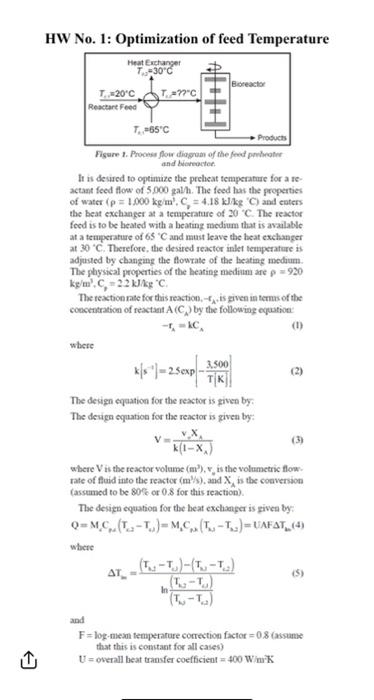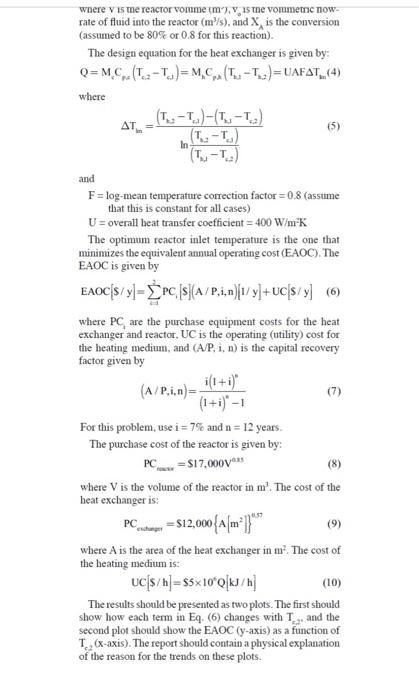HW No. 1: Optimization of feed Temperature Figere 1. Proctse floir didgenati of the fent phoweatior and beveroctee? It is desucd to optumaze the pecheat temapsature for a seactant fecd thore of 5000 eal/h. The foed hat the properties of water ( =1000 kg ma7,Cp=4.18klkg."C) and caters the beat exchanget at a temzperature of M " C. The reactot focd is to be heatcd with a beating macdium that is avalable at a temperature of 65 "C and raust leave the heat exohanger at a0 "C. Thetefore. the dested reactor inlet temaptrafure it adjused by changine the fowraic of the bcating moduum. The physical profkitiks of the seafing medhatm are =920 kmH3,C2,2+kmkeC. The teaction rale for this reastion, tA th given in tctits of the concentration of resctant A(CA) by the followiog equation: fh=kCA where k[s1]=25ckp(T[K]3.500) The decign equation for the reactor is given by. The derign equation for the reactor is given by: v=k(1XA)vAXA where V is the reactor volame (m2),vz is the volumetric flow. rate of fuid into the reactor (m1//s), and Xi is the conversion (assemed to be 80 e or 0.8 for this reaction). The design equation for the beat exchanger is given by: where Tm==ln(Ti,Ts,2)(Tk,2Ti,1)(Ti,1Ts,1)(Ts,3Tc2) and F=log-meantempenaturecorrectionfactor=0.8(assamethatthisisconutantforallcases)U=overallbeattransfercoefficient=400W/mK Wnere v is me reacror voume (m),v, is the vommetnc nowrate of fluid into the reactor (m3/5), and XA is the conversion (assumed to be 80% or 0.8 for this reaction). The design equation for the heat exchanger is given by: Q=McCms(Tc,2Tci)=MhiCin(Ti,2Ti,2)=UAFTin(4) where Tln=ln(Ti,1Ti,2)(Tk,2Tc3)(Tk,2Tc,1)(Ti,3Tc,2) and F=log-mean temperature correction factor =0.8 (assume that this is constant for all cases) U= overall heat transfer coefficient =400W/m2K The optimum reactor inlet temperature is the one that minimizes the equivalent annual operating cost (EAOC). The EAOC is given by EAOC[S/y]=i=12PCi[S](A/P,i,n)[1/y]+UC[s/y] where PC. are the purchase equipment costs for the heat exchanger and reactor, UC is the operating (utility) cost for the heating medium, and (A/P,1,n) is the capital recovery factor given by (A/P,i,n)=(1+i)n1i(1+i)k For this problem, use i=75 and n=12 years. The purchase cost of the reactor is given by: PCmax=$17,000V03 where V is the volume of the reactor in m3. The cost of the heat exchanger is: PCestanger=$12,000{A[m2]}0.57 where A is the area of the heat exchanger in m2. The cost of the heating medium is: UC[$/h]=$5106Q[kJ/h] The results should be presented as two plots. The first should show how each term in Eq. (6) changes with Ta,2 and the second plot should show the EAOC (y-axis) as a function of Te2 (x-axis). The report should contain a physical explanation of the reason for the trends on these plots. HW No. 1: Optimization of feed Temperature Figere 1. Proctse floir didgenati of the fent phoweatior and beveroctee? It is desucd to optumaze the pecheat temapsature for a seactant fecd thore of 5000 eal/h. The foed hat the properties of water ( =1000 kg ma7,Cp=4.18klkg."C) and caters the beat exchanget at a temzperature of M " C. The reactot focd is to be heatcd with a beating macdium that is avalable at a temperature of 65 "C and raust leave the heat exohanger at a0 "C. Thetefore. the dested reactor inlet temaptrafure it adjused by changine the fowraic of the bcating moduum. The physical profkitiks of the seafing medhatm are =920 kmH3,C2,2+kmkeC. The teaction rale for this reastion, tA th given in tctits of the concentration of resctant A(CA) by the followiog equation: fh=kCA where k[s1]=25ckp(T[K]3.500) The decign equation for the reactor is given by. The derign equation for the reactor is given by: v=k(1XA)vAXA where V is the reactor volame (m2),vz is the volumetric flow. rate of fuid into the reactor (m1//s), and Xi is the conversion (assemed to be 80 e or 0.8 for this reaction). The design equation for the beat exchanger is given by: where Tm==ln(Ti,Ts,2)(Tk,2Ti,1)(Ti,1Ts,1)(Ts,3Tc2) and F=log-meantempenaturecorrectionfactor=0.8(assamethatthisisconutantforallcases)U=overallbeattransfercoefficient=400W/mK Wnere v is me reacror voume (m),v, is the vommetnc nowrate of fluid into the reactor (m3/5), and XA is the conversion (assumed to be 80% or 0.8 for this reaction). The design equation for the heat exchanger is given by: Q=McCms(Tc,2Tci)=MhiCin(Ti,2Ti,2)=UAFTin(4) where Tln=ln(Ti,1Ti,2)(Tk,2Tc3)(Tk,2Tc,1)(Ti,3Tc,2) and F=log-mean temperature correction factor =0.8 (assume that this is constant for all cases) U= overall heat transfer coefficient =400W/m2K The optimum reactor inlet temperature is the one that minimizes the equivalent annual operating cost (EAOC). The EAOC is given by EAOC[S/y]=i=12PCi[S](A/P,i,n)[1/y]+UC[s/y] where PC. are the purchase equipment costs for the heat exchanger and reactor, UC is the operating (utility) cost for the heating medium, and (A/P,1,n) is the capital recovery factor given by (A/P,i,n)=(1+i)n1i(1+i)k For this problem, use i=75 and n=12 years. The purchase cost of the reactor is given by: PCmax=$17,000V03 where V is the volume of the reactor in m3. The cost of the heat exchanger is: PCestanger=$12,000{A[m2]}0.57 where A is the area of the heat exchanger in m2. The cost of the heating medium is: UC[$/h]=$5106Q[kJ/h] The results should be presented as two plots. The first should show how each term in Eq. (6) changes with Ta,2 and the second plot should show the EAOC (y-axis) as a function of Te2 (x-axis). The report should contain a physical explanation of the reason for the trends on these plots








